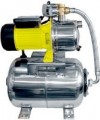Maximum performance
The maximum volume of water that the device can pump in a certain amount of time. It is one of the key specs of any pump because characterizes the volume of water with which the device can work. At the same time, it does not always make sense to pursue maximum performance — after all, it significantly affects the dimensions and weight of the unit.
Some formulas allow you to derive optimal performance values for different situations. So, if the pump is designed to supply water to water intake points, its minimum required performance should not be lower than the highest total flow rate; if desired, a margin of 20-30% can be added to this value. And for sewer models (see "Suitable for"), everything will depend on the volume of wastewater. More detailed recommendations for choosing a pump depending on performance can be found in special sources.
Maximum head
The maximum head generated by the pump. This parameter is most often indicated in meters, by the height of the water column that the unit can create — in other words, by the height to which it can supply water. You can estimate the pressure created by the pump using a simple formula: every 10 m of head corresponds to a pressure of 1 bar.
It is worth choosing a pump according to this parameter, taking into account the height to which it should supply water, as well as adjusting for losses and the need for pressure in the water supply. To do this, it is necessary to determine the difference in height between the water level and the highest point of water intake, add another 10 to 30 m to this figure (depending on the pressure that needs to be obtained in the water supply), and multiply the result by 1.1 — this will be the minimum pressure required.
Max. pressure
The highest pressure that the pump is capable of creating during operation. This parameter is directly related to the maximum head (see above); however, it is less obvious, and therefore, it is indicated rarely.
Suction height
The largest difference between the height of the pump and the height of the water level at which the pump can provide normal suction. Without special devices, the maximum value of this parameter is 7-8 m — this is due to the physics of the process. However, when using an ejector (see below), the suction height can be increased several times.
Maximum particle size
The largest particle size that the pump can handle without problems. This size is the main indicator that determines the purpose of the device (see above); and in general, the larger it is, the more reliable the device, the lower the risk of damage if a foreign object enters the suction line. If the risk of the appearance of too large mechanical impurities is still high, additional protection can be provided with filters or grids at the inlet. However, such a measure should be considered only as a last resort, because from constant exposure to solid particles, the grids become clogged and deformed, which can lead to both clogging of the line and filter breakthrough.
Mechanical impurities
The maximum amount of mechanical impurities in the suction water at which the pump can operate normally (of course, if the particles of these impurities do not exceed the maximum size possible for this model; see above for details). Pure water is considered to be water with an impurity content of up to 20 g per cubic meter, but in sewage, the bill can already go to tens of kilograms per cubic meter.
pH value
The pH value of the pumped liquid for which the pump is designed. This indicator describes the level of acidity of the medium, roughly speaking, how reactive it is to the “acidic” or “alkaline” side: low pH values correspond to an acidic environment, and high pH values are alkaline. Acid and alkaline have different effects on the materials used in the construction of various equipment, including pumps. Therefore, when designing parts in direct contact with the liquid, the pH level must be taken into account, and the use of the pump with unsuitable substances is not recommended — this can lead to corrosion, which affects the composition of the pumped liquid and reduces the life of the unit. However, this parameter is critical mainly for specialized models such as pumps for chemical liquids or sewage (see "Suitable for"). In ordinary water (even dirty) the pH range is not so extensive that it cannot be covered entirely.
Ejector
The presence of an ejector in the design or delivery set of the pump.
The main purpose of the ejector is to increase the effective suction height. Its action is based on the fact that part of the water pumped by the pump is sent back down to the intake point; this water in some way "pushes" the water in the main suction line. Thanks to this, the suction height can be increased from 7-8 m, available without an ejector, to 15-20 m. The main disadvantage of this device is a rather high noise level.
Maximum power
Rated power of the pump motor. The more powerful the engine, the higher the performance of the unit, usually, the greater the pressure, suction height, etc. Of course, these parameters largely depend on other features (primarily the pump type, see above); but models similar in design can be compared in terms of power.
Note that high power, usually, increases the size, weight and cost of the pump, and also implies high costs of electricity or fuel (see "Power source"). Therefore, it is worth choosing a pump according to this parameter taking into account the specific situation; more detailed recommendations can be found in special sources.

